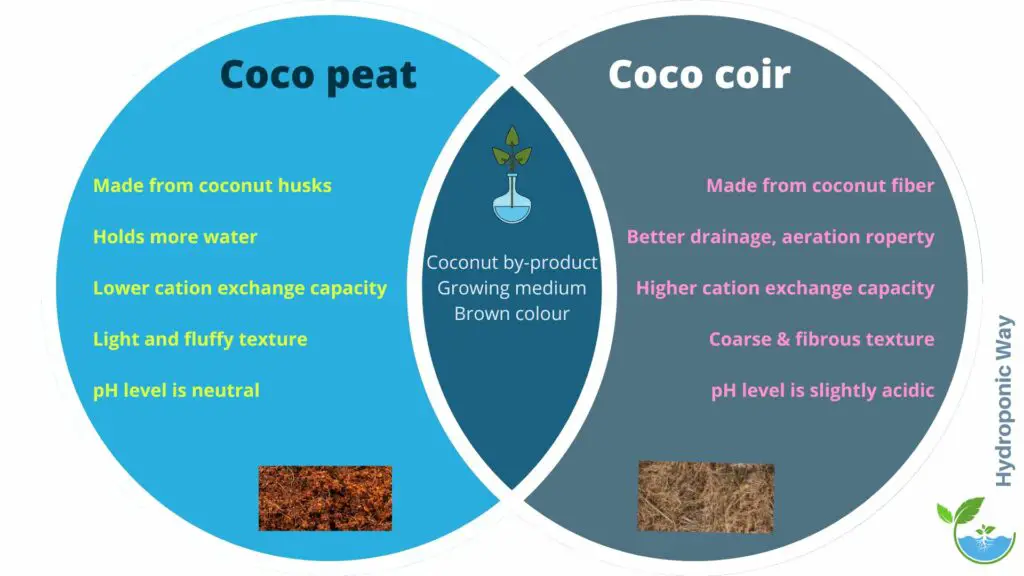Coco Peat vs Coco Coir: What’s the Difference?
Disclosure: Your purchases through our links may earn us a small commission, supporting our site’s ability to provide valuable information to our readers. Rest assured, it won’t impact your price. Thank you for your support.
There are many different types of substrates or growing mediums to choose from when it comes to growing plants. Two of the most popular choices are coco peat and coco coir.
Coco peat and coco coir are both excellent substrates for plants. But before you can decide which one is right for you, it’s essential to understand the difference between them.
We will discuss the differences between coco peat and coco coir and help you decide which one is right for you!
Coco Peat vs. Coco Coir: Which One Is Right for You?
Coco peat and coco coir are both excellent substrates for gardening applications.
- Both are a byproduct of the coconut industry. They are environmentally friendly and sustainable.
- Both are versatile and can be used in various ways, such as a potting mix, added to soil to improve drainage, or even used on their own as a hydroponic growing medium.
- Unlike other plant materials, coco coir and coco peat will maintain their structural integrity for an extended period.
- Coco coir and Coco peat can be used as a soil amendment, erosion control agent, or plant-growing medium. It is also high in carbon, making it an excellent choice for composting.
- Both can be used as mulch.
- Coco peat and coco coir are natural materials that boast a pH level hovering around neutral, typically between 5.5 and 6.5.
Let’s go in deep to know the technical properties of each of them.
Coco peat
Pros
- It’s light and fluffy structure offers excellent moisture retention, and nutrient availability.
- Coco peat often leans towards the slightly more acidic side, which means its pH might dip a bit lower within that range. This subtle difference can influence nutrient availability in the growing media.
Cons
- It has a tendency to compact over time, which can reduce its effectiveness as a soil amendment.
Coco Coir
Pros
- It’s coarse and fibrous structure leads superior aeration and drainage characteristics.
Cons
- It has neutral pH level and offers less nutrient availability than coco peat, which may limit its effectiveness for certain types of plants.
Related: How to Use Coco Peat to Grow Plants and for Seed Germination?

Related: How to Grow Hydroponic Plants with Coco Coir?

How to Make Coco Peat at Home Step by Step from Raw Coconut?
Follow the steps and instructions provided below
To make coco peat and coco coir, you will need the following:
- A sharp knife
- A cheese grater
- A blender or food processor
- A strainer
- A bucket or container to hold the finished product
Collect coconuts from a local grocery store or farmer’s market. Make sure to get unsweetened coconuts, as the sweetened variety will produce a syrup that is difficult to remove.
Remove the meat from the coconuts and set it aside for another use.
Instructions to make coco peat at home:
- Grate the coconut husks into small pieces using a cheese grater.
- Using a blender or food processor, you can cut the husks into smaller pieces before adding them to the machine. Blend or process the husks until broken down into a fibrous pulp.
- Strain the pulp through a strainer to remove any large pieces. The finished product should be a light, fluffy material that resembles peat moss. Store the coco peat in a bucket or container until you can use it.
- Making the coco peat without machine blending will make it more difficult to remove the husks from the finished product. However, this method will produce higher-quality coco peat that is less likely to compact.
Related: 5 Disadvantages of Coco Peat: What You Need to Know
Instructions to make coco coir at home:
- The fiber is separated from the rest of the coconut and then dried to make coco coir.
How to Buy Coco Peat and Coco Coir?
Coco peats and coco coir come in various forms, including block/brick and plug-coins or bales.
Coco blocks and bricks are famous for growing mediums because they’re easy to store and use for small gardens with less space.
Coco plugs, also known as coins, are an easy to handle and perfect for small seedlings or plants.
Click here if you are looking to buy the highest quality Coco blocks or bricks and Coco plugs.
How to Make a Coco Peat or Coco Coir Potting Mix?
Making a coco peat or coco coir potting mix is easy. You will need the following ingredients:
- Coco peat or coco coir
- Potting soil
- Compost
- Vermiculite or perlite
Measure out equal parts of coco peat, potting soil, compost, vermiculite, or perlite. Mix them in a large container until the ingredients are well combined. Store the potting mix in a sealed container until ready to use it.
To use the potting mix, moisten it before you plant your seeds or transplants. Once the plants are in the potting mix, moisten them well.
Read to know
Pros and Cons of Drip Hydroponic System
I hope you can select the best among coco peat and coco coir for your garden now.
Click here if you are looking for Coco peat, Coco peat coins, or Coco coir for your garden.
Thank you for reading!
Also, read the following:
Rockwool vs. Coco Coir: Which Is the Right Choice for You?
Hydroponic Growing Mediums
How to Grow Hydroponic Carrots for an Abundant Harvest





